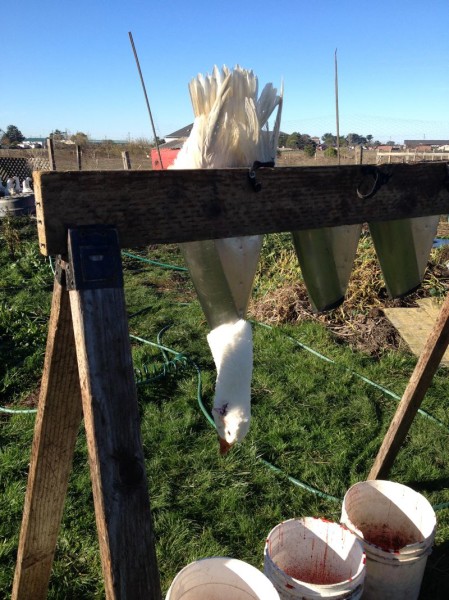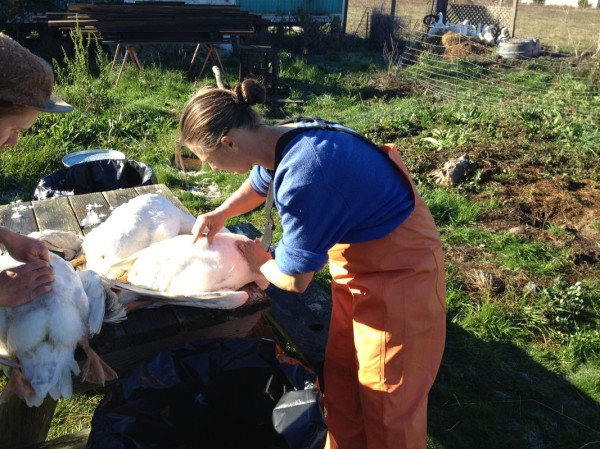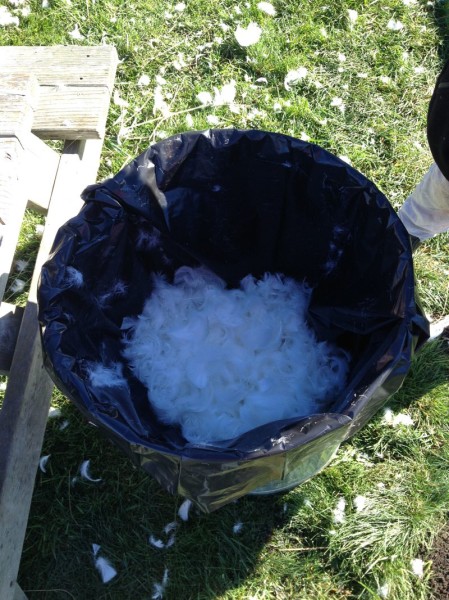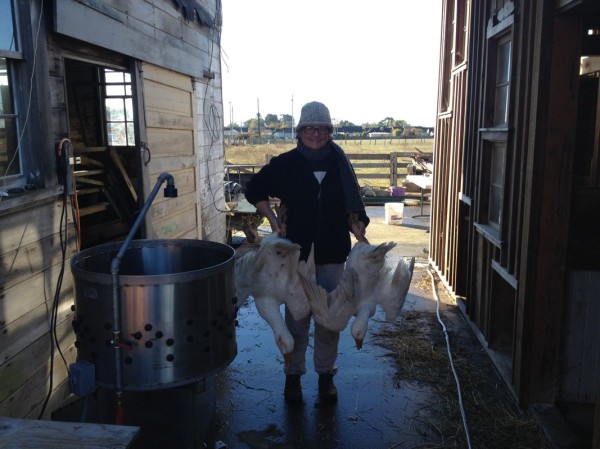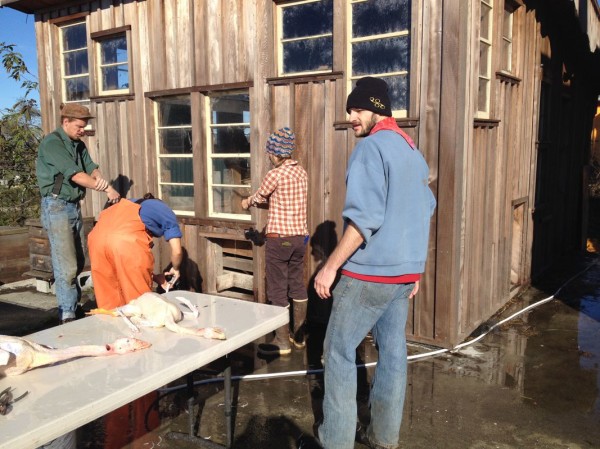Journal #7: Killing Time
by Miles Raymer
I think it’s a fair assertion that anyone willing to eat the meat of another animal ought to also be willing to participate in that animal’s death. The experience of killing animals for sustenance, which has been commonplace for most humans throughout our history, is now just one item on the long list of productive activities from which normal folks (at least in the first world) can be easily exempted. Industrialization has rendered the killing of animals and the processing of meat something that takes place largely behind closed doors, far from prying eyes and fresh air. Learning about the horrors of factory farming was a big step for me in the process of becoming interested in sustainable agriculture, so I was excited when Shail at Tule Fog Farm invited me to participate in their annual goose slaughter the week before Thanksgiving. It was the first time I’d ever killed an animal that would be used for human consumption––an experience I’d been craving for a long while. Ma has also taken an interest in slaughtering, so she came along with me. We were eager to discover how it would feel to kill, to watch the life of one creature drain away in order to appropriate its energy to fuel another. And while neither of us experienced any of the physical revulsion that sometimes overtakes those new to slaughtering, we were struck by the combination of tranquility and brutality that pervaded the process.
Before any killing took place, Shail had everyone stand outside the goose pen and share a quiet moment of thanks. She put out a tub of water the night before, so the geese had spent the last few hours splashing about, and their feathers were clean and radiant. Shail said she hoped they’d enjoyed their life and that she was grateful for their sacrifice so that she could continue to make her living. Throughout the day, I also saw Shail thank each goose individually, and I tried to remember to do the same.
To kill a goose, I had to first step into the pen and chase the geese until I could grab one and lift it into the air, away from its honking companions. I’ll make no claims about exactly how much the geese understood about what was happening to them, but I also won’t downplay the level of raw fear exuded by these beautiful white birds––it was palpable. It was hard not to think of myself as monstrous as I turned my first bird upside down and forced it into the metal cone where the final moments of its life would be spent. Demonstrating with her own bird, Shail showed me how to put my hand on the goose’s neck to find the esophagus and push it aside with my thumb. Next, she used a sharp knife to cut straight into the neck and then out, away from the esophagus. I followed suit, with varying success. When done properly, this quick motion severed a major artery and the bird began to quickly bleed out. When done improperly, I sometimes had to make up to four or five additional cuts to get the blood flowing, all while cursing myself for increasing the suffering of this animal beyond necessity. Once the birds began to bleed, we held their necks at an angle to help the blood drain. Slowly, their bodies began to shut down. In the final moments, their muscles convulsed and heads bobbed frantically, eyes still moving with a vestige of consciousness I wasn’t sure if I could trust. Eventually, the birds stopped struggling and hung limp.
After the birds were dead, we harvested their breast feathers as well as the down (this part of the process is called “dry plucking”). It was interesting to learn the difference between these two resources; I’d always assumed that goose “down” was the same as feathers, but they are actually two separate layers of insulation. As we plucked, we deposited the feathers and down into two separate trash bags. Putting my hand into the down bag was like touching a cloud; I’ve never felt anything softer.
“Wet plucking” came next. This segment included dunking the carcasses in scalding water and then throwing them into a wet plucker, which spun the body in order to strip off as many feathers as possible. After they made it through the machine, we had to do the rest of the plucking by hand. This was by far my least favorite part of the slaughtering process. Because these geese were going out in Tule Fog’s meat share and weren’t for personal consumption, we had to clean them very meticulously. The food industrial complex has made people very particular about the appearance of meat (and, ironically, quite unscrupulous when it comes to its nutritional content), so we had to make the birds look as “nice” as possible. Shail told me that, were she to harvest the birds for personal consumption, she would just skin them, thereby obviating the need for thorough plucking.
After the carcasses were completely clean, Shail cut off the heads and feet, and then eviscerated the birds to harvest the major organs: heart, liver, gizzard. I helped her with the gizzards, which was fun and educational for me. I didn’t know that gizzards help birds grind down their food in the way that teeth function for most mammals, so I was surprised and fascinated to cut the gizzards open and discover a dark green mixture of pebbles (which the birds have evolved to eat compulsively) and plant matter. Shail explained to me that the pebbles grind up the grass, making it easier for the geese to digest.
I had to leave about an hour before we finished processing all 21 geese, but was able to see a few of them all the way into the plastic bags in which they would be delivered to customers. I felt fortunate not only to witness the process from start to finish, but also to participate in it in a meaningful way. A very friendly group of volunteers came out to help Shail with her work, so even though it was a long day of difficult labor, we kept our spirits up with jokes and interesting conversation. It was a true community event, with participants from several generations all pitching in together.
Personally, I am still parsing the emotional experience of slaughtering the geese. I don’t have any moral objections to killing animals in this kind of fashion, which is generally respectful of the creature and accomplished in a way that allows the animal to live a normal life without confinement prior to slaughtering. Still, the wild fear of those final moments sticks with me. No matter how peaceful I tried to make it, the killing process ultimately amounted to cornering a scared creature, wrestling it into submission, and forcibly taking its life. The greatest lesson I learned was that, even in the best of circumstances, there is no escaping that direct confrontation with my own role as killer––not if I want to harvest animals in the personal way that I know is more ethically defensible than our societal standard. There is also no escaping the quiet stillness in the moment of death, that peaceful dissipation of care and earthly burden. Taken together, I’m not sure if I’ll ever become entirely comfortable with these images, which is perhaps not even an achievable or desirable goal. But, as with many new experiences, I’m grateful for the insight it has brought me, and I will continue to think on it as my plans to eventually harvest my own meat (or not) take shape.
